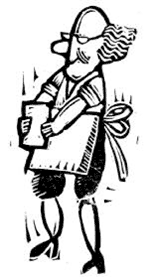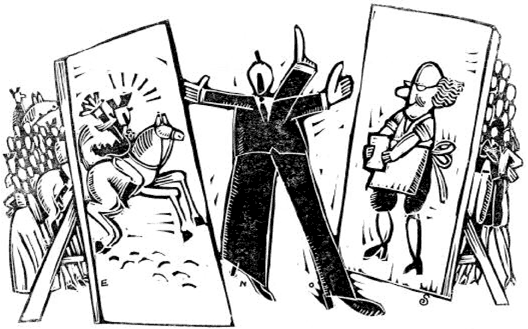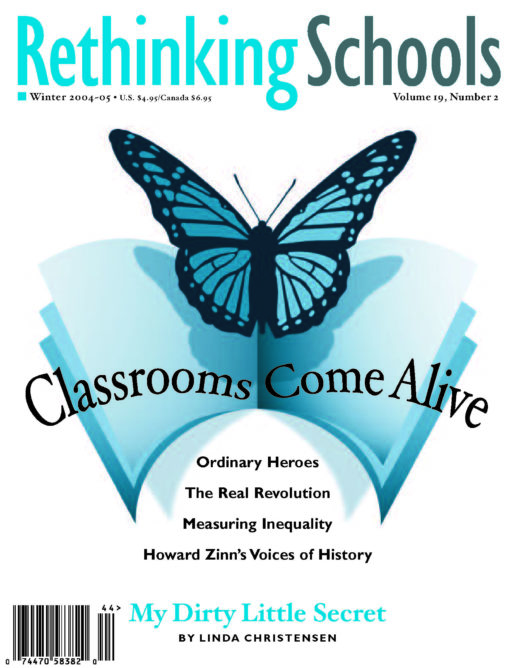Re-examining the Revolution
What's the harm in celebrating the myths of our nation's founders? Plenty.
Illustrator: Randall Enos

History, like politics, is based on framing and spin. For two centuries, authors of history texts have used whitewashed tales of our nation’s founding to provide young people with a shared view of America, a national self-portrait deemed to be patriotic. The biases in old textbooks are transparent—but have we left mythologizing behind?
Although textbooks in recent years have certainly become more inclusive, giving the nod to multiculturalism is not synonymous with getting the story right. We’ve come a long way, baby—but we have a long way to go.
In conjunction with my latest book, Founding Myths: Stories that Hide our Patriotic Past , I have reviewed 22 current elementary, middle school, and high school texts. Fourteen were displayed at a recent National Council for the Social Studies convention, while eight are approved for use in California, which has among the strictest criteria in the nation. I compared the 13 mythologies of the American Revolution discussed in my book with those perpetuated in these texts, and the results are startling. Although some texts fare better than others, all contain some serious lapses.
Myths That Persist
Most texts do mention African-American participation in the war, but they focus primarily on those who sided with the Americans. In fact, those who sided with the British were far more numerous, but you’d never guess it from reading the texts. When they offer numbers, they typically compare the estimated number of black patriot soldiers during the course of the entire war (5,000) with the number of slaves who sought freedom with the British in a single week (generally cited as 300). The myth of the patriotic slave is not far removed from that of the happy slave.
Current texts do include some mention of the Native-American presence in the Revolutionary War, but their narratives display a serious bias. In fact, white colonists were looking west as well as east before, during, and after the war, but the texts do not discuss their drive to acquire trans-Appalachian lands—a major cause of the Revolution. They do not mention the extensive land speculation of George Washington, Thomas Jefferson, Patrick Henry, and other “Founding Fathers.” The American Revolution was the largest conflict between Native Americans and European Americans in our nation’s history, but students will not learn this by dutifully reading their assignments.
All elementary and middle school texts report the exploits of George Rogers Clark and his small band of frontiersmen, who supposedly “opened” the West. The authors of Harcourt’s Horizons write, “George Rogers Clark helped protect the frontier lands claimed by many American settlers.” Then, to ensure that students did not miss the message, they ask: “Review: Who defended settlers in the western lands?” In this one question, a war of conquest is turned on its head.
By contrast, not one of the elementary or middle school texts even mentions the genocidal Sullivan campaign, one of the largest military offensives of the war, which burned Iroquois villages and destroyed every orchard and farm in its path to deny food to Indians. Serious treatments of white conquest appear earlier (17th century) and later (19th century) in these texts, but not at the critical point of our nation’s founding. Right at the moment of the greatest white incursion onto Native lands in United States history, the Indian presence mysteriously disappears. The pan-Indian resistance movements of the 1780s—the largest coalitions of Native Americans in our history—are entirely neglected. With nary a word about the impact on indigenous people, the texts uniformly celebrate the ordinances of 1785 and 1787—blueprints for westward expansion and death knells for Indian sovereignty.
In their eagerness to find female heroines of the Revolutionary War, 18 of the 22 texts feature the story of Molly Pitcher. They reify this folkloric legend into a real person, pronouncing unabashedly that she was Mary Hayes. (The legend did not settle on a flesh-and-blood woman until the 1876 Centennial, based only on the word of a local promoter from Carlisle, Pa.) Most texts display one of the 19th century romantic paintings of Molly firing her cannon. The pictures appear old and suitably historic—no matter that these fantasies were painted in the following century.
Our texts are based on warmed-over tales of the 19th century such as Patrick Henry’s “Liberty or Death” speech (written by William Wirt in 1817, 42 years after the fact) and “Paul Revere’s Ride” (popularized in 1861 by Henry Wadsworth Longfellow, who distorted every detail of the event to enhance his story). Although many historians know better, these stories work so well that they must still be included, regardless of authenticity or merit.
More of the myths are perpetuated in elementary and middle school texts than in AP high school texts, but this raises a troubling question: Why are textbook authors telling stories that they know to be false? Worse yet: Why do they give these tales their stamp of approval and call them “history”?
Of all the texts, the one that perpetuates the most untruths about the American Revolution—I found a whopping 17—is Joy Hakim’s immensely popular A History of US . This is no accident. Hakim, who has done so much to make history more inclusive, is a masterful storyteller, and she has based her account on how stories play to young readers, not on whether they are true. She is the only current textbook author to perpetuate the story of Paul Revere waiting to view the signal lanterns (“One if by land, two if by sea”), a Longfellow fabrication. She not only attributes the words of William Wirt to Patrick Henry, she also tells her young readers what gestures Henry made as he uttered each phrase. She takes Ralph Waldo Emerson’s “Concord Hymn” and mysteriously places it at Lexington, because it seems to fit the story there.
How do textbook writers deal with advances in modern scholarship that disprove, or at least deconstruct, the myths?
In 1996, David Hackett Fischer published his remarkable deconstruction and reconstruction of Paul Revere’s ride. Fischer showed that Revere was not such a solitary hero. Instead, he was part of an intricate web of patriots who rode horses, rang bells, and shot guns to sound the warning. Fischer’s book was so popular that textbook writers had to deal with this new information. Revere was not alone, they now admit. William Dawes (and sometimes Samuel Prescott) rode as well. They water down the legend, but they do not embrace the real impact of Fischer’s findings: The mobilization of April 18-19, 1775, was a truly collaborative effort involving an entire population.
In 1997, Pauline Maier published American Scripture , where she uncovered 90 state and local “declarations of independence” that preceded the U.S. Declaration of Independence. The consequence of this historical tidbit is profound: Jefferson was not a lonely genius conjuring his notions from the ether; he was part of a nationwide political upheaval. Again, textbook writers have watered down the legend while missing the main point. Many now state that Jefferson was part of a five-man congressional committee, but they include no word of those 90 documents produced in less-famous chambers.
Coverup
Some say these myths are harmless—what damage can stories do? Plenty. They change our view of historical and political processes. Myths that celebrate individual achievement mask fundamental truths of great importance. The United States was founded not by isolated acts of heroism but by the concerted revolutionary activities of people who had learned the power of collaborative effort. “Government has now devolved upon the people,” wrote one disgruntled Tory in 1774, “and they seem to be for using it.” That’s the story the myths conceal.
For example, in 1774 common farmers and artisans from throughout Massachusetts rose up by the thousands and overthrew all British authority. In the small town of Worcester (only 300 voters), 4,622 militiamen from 37 surrounding communities lined both sides of Main Street and forced the British-appointed officials to walk the gauntlet, hats in hand, reciting their recantations 30 times each so everyone could hear. There were no famous “leaders” for this event. The people elected representatives who served for one day only, the ultimate in term limits. “The body of the people” made decisions and the people decided that the old regime must fall.
Similar transfers of power were repeated in every county seat outside Boston. By early fall—half a year before Lexington and Concord—British rule had come to an end, both politically and militarily, for 95 percent of the inhabitants of Massachusetts. On October 4, 1774—21 months before Congress would approve the Declaration of Independence—the people of Worcester proclaimed that the old constitution was dissolved and that they should begin to form a new one, “as from the ashes of the Phenix.”
This was the most successful popular uprising in our nation’s history—so why is it not part of the core narrative of the Revolution? It used to be. Mercy Otis Warren, a patriot who wrote one of the early histories, called the 1774 rebellion “one of the most extraordinary eras in the history of man.” Other early historians covered the events in some detail.
But then came the myths. “The shot heard round the world” (Ralph Waldo Emerson, 1836) told us the Revolution started on April 19, 1775, effectively muzzling the one that came before it. The Sam Adams myth (first perpetuated by his Tory opponents, and not adopted by most Americans until the mid-19th century) said that all revolutionary actions in Massachusetts emanated from a single mastermind; since Adams was not present at the rural rebellions, nothing possibly could have happened. Paul Revere’s Ride (Longfellow, 1861) said that farmers had to be awakened from their slumbers by a man from Boston, even though the farmers themselves had already staged a revolution and spent six months arming themselves to defend it. The myth that Jefferson was responsible for the ideas in the Declaration of Independence (initiated by his political supporters) hid the fact that people from the hinterlands of Massachusetts were ready to go that route long before. The end result: Not one current textbook chronicles the first overthrow of British rule. How strange that the story of any revolution can be told without at least a mention of the initial overthrow of political and military authority. This is the damage of myth making—real history gets lost, much of it very important.
There is another serious danger: The doctored tales further the same jingoistic interests they were intended to promote when first created in the 19th century. Crucial to the self-image of America is the notion that a handful of dedicated patriots were able to cast off the yoke of the mighty British Empire. “David had licked Goliath,” Joy Hakim writes proudly. “A superpower had been defeated by an upstart colony.” But our nation was not like David then, nor is it now. David fought alone, while the United States prevailed in the Revolutionary War in large measure because Europe’s greatest powers—France, Spain, and the Netherlands, with Russia about to join at war’s end—were fighting the British in North America, the West Indies, the North Sea, the English Channel, Gibraltar, the Mediterranean Sea, South Africa, India, and the East Indies. This is why the British decided on a strategic withdrawal. There’s not a word of this in our textbooks, nothing more than a little help from the French. Ironically, the historical self-portrait of America as the little guy, together with a myopic denial of international politics, fuels the quest for unbounded global power. We were attacked at Lexington, we like to believe, and we fought them off. We were attacked on 9/11, and we will fight them off. Just us, the victims. We continue to see ourselves as David to prove we are not Goliath, no matter how much we bully others.

A Never-ending Story
The tales linger on not only because they perpetuate American jingoism, but also because they make wonderful stories. As teachers, we all know the power of a good narrative. But this power is easily abused. Like rumors, some tales are too good not to be told. Of these especially we must beware. They are carefully crafted to fit a time-tested mold that features heroes or heroines, clear plot lines, and happy endings. Good does battle against evil, David beats Goliath, and wise men prevail over fools. Stories of our nation’s founding mesh well with these narrative forms. American revolutionaries, they say, were better and wiser than decadent Europeans. Outnumbered colonists overcame a Goliath, the mightiest empire on earth. Good prevailed over evil, and the war ended happily with the birth of the United States. Even if they don’t tell true history, these imaginings work as stories. Much of what we think of as “history” is driven not by facts but by these narrative demands.
Since our stories need protagonists, we marshal forth heroes and heroines to represent the people of the times. Although selected for their uncommon features, these few are made to signify the whole. George Washington, Benjamin Franklin, Thomas Jefferson—we speak of these illustrious individuals as the Revolutionaries, and we use them to stand for all the other Revolutionaries, even as we proclaim they are special, not like the others. These people are then called “leaders;” all others become mere followers. A handful of celebrated personalities make things happen, the rest only tag along; a few write the scripts, the rest just deliver their lines. This turns history on its head. In reality, so-called leaders emerge from the people—they gain influence by expressing views that others espouse. In the telling of history, however, the genesis of leadership is easily forgotten.
Textbook authors and popular history writers fail to portray the great mass of humanity as active players, agents on their own behalf. Supposedly, only leaders function as agents of history. They provide the motive force; without them, nothing would happen. The famous Founders, we are told, made the American Revolution. They dreamt up the ideas, spoke and wrote incessantly, and finally convinced others to follow their lead. But in trickle-down history, as in trickle-down economics, the concerns of the people at the bottom are supposed to be addressed by mysterious processes that cannot be delineated. What happens at the top is all that really counts. This distorts the very nature of the historical process, which must, by definition, include masses of people.
It is through the study of history that young people first learn about politics and power. By the time seniors in high school finally get around to studying “politics and government,” they have been reading and hearing stories for many years about individuals and social groups who struggled for power. They have already learned and internalized a “grammar” they will use to decipher political events.
So what has their study of history taught them about politics and power? To the extent that their curriculum has been based on stories with traditional narrative structures, students will have developed a political grammar that is individualistic and linear. They will have learned that historical actors function as autonomous bundles of free will, devoid of context. Most standards ask students to study “key individuals” and they learn that those individuals have an impact on events. But U.S. textbooks and many curricula do not teach that events have an impact on individuals. The lines of influence are all in one direction. People magically conjure ideas with little help from their friends, then use these ideas to make history happen.
When political dynamics are personalized and simplified in this manner, students do not learn to understand the real workings of power. They are not encouraged to explore some very important questions: How do certain individuals manage to exert control over others? How do people come together to resist domination and stand up for their own interests? History abounds in lessons that would shed light on these matters, but the lessons cannot be learned when the forces that drive politics are kept secret, hidden by tales designed to tout and promote individual achievement.
The way we learn about the birth of our nation is a case in point. If we teach our students that a few special people forged American freedom, we misrepresent, and even contradict, the spirit of the American Revolution. Our country owes its existence to the political activities of groups of dedicated patriots who acted in concert. Throughout the rebellious colonies, citizens organized themselves into an array of local committees, congresses, and militia units that unseated British authority and assumed the reins of government. These revolutionary efforts could serve as models for the collective, political participation of ordinary citizens. Stories that focus on these models would confirm the original meaning of American patriotism: Government must be based on the will of the people. They would also show some of the dangers inherent in majoritarian democracy: the suppression of dissent and the use of jingoism to mobilize support and secure power. They would reflect what really happened, and they would reveal rather than conceal the dynamics of political struggle.
Instead, the democratic nature of our nation’s creation is hidden from view by stories fashioned in a different mold. Individual heroics trump collective action; the few take the place of the many. Both real history and the meaning of American democracy are lost in the translation.

